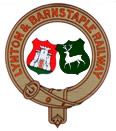|

The Lynton & Barnstaple Railway (L&B) opened
as an independent railway in May 1898. It
was a single track narrow gauge railway just
over 19 miles (30 km) long running through
the rugged and picturesque area bordering
Exmoor in North Devon, England. Although
opened after the 1896 Light Railways Act
came into force, it was authorised and
constructed prior to that act. Therefore, as
with all other railways, it was authorised
under its own Act of Parliament and built to
higher (and more costly) standards than
similar railways of the time. In the United
Kingdom it was notable as being the only
narrow gauge line required to use main-line
standard signalling.
For a short period the line earned a modest
return for shareholders, but for most of its
life the L&B made a loss. In 1922 the L&B
was taken over by the Southern Railway, and
eventually closed in September 1935.
Following the opening of the Devon and
Somerset Railway to Barnstaple, there were
calls for an extension to serve the twin
villages of Lynton and Lynmouth, which were
popular with holiday-makers.
Through the middle of the 19th century,
several schemes were proposed, from
established railway companies and
independent developers. One scheme suggested
electric power, while another proposed a
line from South Molton. None of these
schemes offered sufficient prospects to
encourage investment, and few got further
than initial plans.
Due to the difficult terrain, one scheme
suggested a gauge of 1 ft 11 1⁄2 in (597
mm), already in use by the Festiniog Railway
Company and elsewhere, to ease construction.
This scheme was supported by Sir George
Newnes who became chairman of the company.
The Lynton & Barnstaple Railway Bill was
passed on 27 June 1895, and the line opened
on 11 May 1898 with public service
commencing on 16 May, connecting with trains
from Waterloo on the Ilfracombe Branch Line
at Barnstaple Town.

Sir George Newnes
The scheme did not meet with universal
enthusiasm, and from the beginning, there
were some who doubted the true intentions of
the promoters. Although many of the sinuous
curves and deviations were due to having to
maintain a 1 in 50 gradient where there was
no leeway (Most observers being oblivious to
the fact that a straighter shorter line
would have made the gradient even steeper),
several were due to resistance by local
landowners along the route.

A guide published whilst the line was being
built stated:
“ On the highest point at Lynton a
pretentious mansion has been built for
himself by the proprietor of a certain well
known publication, whom some look on as the
benefactor and others as the evil genius of
the place. Through his enterprise it is that
the "lift" was made in 1888, to be cursed by
conservative and artistic souls, but blessed
by unwieldy bodies and rheumatic limbs; he
has also favoured the railway, now a fait
accompli, and the pier which seems so much
wanted. Yet whatever may be said of the
railway, there is good reason for doubting
if the pier would be a real advantage. It
would certainly flood the place with a class
of excursionists for whom there is little
accommodation, and on whom, for the most
part, its characteristic beauties would be
thrown away. ”

early days at Blackmoor Station
The L&B seldom attracted sufficient
passengers to remain viable. The journey of
nearly twenty miles took on average an hour
and a half. To satisfy several influential
residents, the terminus at Lynton was some
distance from the town itself, and from the
cliff railway to Lynmouth.
Declining tourism during World War I,
improved roads, increased car ownership
further depleted the line's income until it
was no longer economic. A guidebook
published in 1921 described the situation:
“ The railway which has made this corner
more accessible is of narrow gauge,
requiring a change of carriage at the Town
station, Barnstaple. ... Unfortunately, this
line does not seem to be a financial
success, and its service, out of season at
least, is not a very liberal one. ”

Southern Railway Days
Despite numerous cost-saving measures and
extra investment in the line, the Southern
Railway was unable to reverse the trend, and
closed the line.
The last train ran on 29 September 1935. The
Southern removed everything they could use
elsewhere, and by 8 November, had lifted the
track from Lynton to Milepost 15 - on the
Barnstaple side of Woody Bay station. On 13
November an auction was held, although the
railway failed to attract much interest.
Most rolling stock, and all but one loco,
was sold for scrap and broken up at Pilton.
Some coaches were sectioned for use as
garden sheds. Third class seats became
garden furniture, and first class seats
found their way into local snooker halls and
Masonic Lodges. In December, Plymouth ship
breaker Sidney Castle won the tender to
dismantle the railway. The remaining track
was lifted by June 1936, and in September,
surviving loco Lew was shipped abroad. The
stations and track bed were auctioned in
1938.

Lynton Station after the track is lifted
Bratton Fleming

early days at Bratton Fleming
The railway ran
through sparsely populated countryside. The
importance and size of stations seemed to
bear no relationship whatsoever with the
local population. Initially, Bratton Fleming
was provided with a loop, two sidings, a
goods shed and was fully signalled. In later
years, the loop and one goods siding was
removed along with the signals. The building
still exists and is now a private house.

Bratton Fleming in later years as modelled

|